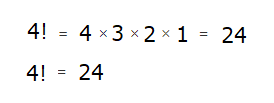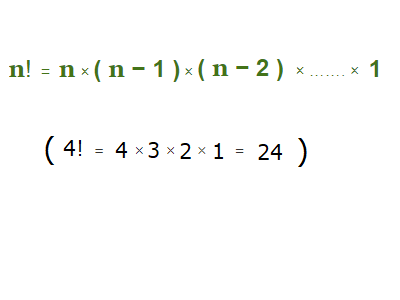The factorial of a positive number is a product, it is a multiplication of the relevant number with a descending list of other lesser numbers.
The factorial symbol for dealing with factorials of numbers is the exclamation mark. !
Thus five factorial looks like 4!.
What exactly does 4! look like as a sum?
It’s multiplying a sequence of descending numbers, starting with 4, and ending with 1.

However, there are times when 4! can also be written as 1 × 2 × 3 × 4.
But both forms give the same result.
Factorial General Case
We can write down a general formula for the factorial of a specific number.
6!
Similar to 4!, we can consider 6!.6! = 6 × 5 × 4 × 3 × 2 × 1 = 720
6! = 720
As we can see, the result of 6! is much larger than 4!.
The results of factorials in fact do increase in size very quickly as you go up a number.
Compared to the jump from the result of 4! to 6!.
The jump from the result of 6! to 7! is even larger.
7! = 7 × 6 × 5 × 5 × 3 × 2 × 1 = 5’040
7! = 5’040
Once we get past 9! and into double figure numbers, we do start to get some very large numbers from factorial calculations.
Factorial of 0!
Perhaps not what many people would expect, 0! results in a value of 1.
Why is this?
Firstly, consider the values of 1! up to 5!.
1! = 1 , 2! = 2 , 3! = 6 , 4! = 24 , 5! = 120
From here, we can start working backwards to observe the pattern.
5! = 120
4! = 24 = \bf{\frac{120}{5}} = \bf{\frac{5!}{5}}
3! = 6 = \bf{\frac{24}{4}} = \bf{\frac{4!}{4}}
2! = 2 = \bf{\frac{6}{3}} = \bf{\frac{3!}{3}}
1! = 1 = \bf{\frac{2}{2}} = \bf{\frac{2!}{2}}
0! = \bf{\frac{1!}{1}} = 1
Simplifying Factorials of Numbers
It’s possible in Math to encounter fractions that contain or involve factorials, and these fractions can man times be simplified.
Say you had \bf{\frac{6!}{4!}}, this can be written as \bf{\frac{6\space\times\space5\space\times\space4\space\times\space3\space\times\space2\space\times1}{4\space\times\space3\space\times\space2\space\times\space1}}.
The 4 × 3 × 2 × 1 on the top and bottom line can be cancelled, leaving just 6 × 5.
So \bf{\frac{6!}{4!}} = 6 × 5 = 35.
This process also follows with similar situations involving fractions and factorials.
Examples
\bf{\frac{19!}{17!}} = 19 × 18 = 342
\bf{\frac{24!}{21!}} = 24 × 23 × 22 = 12’144
\bf{\frac{4!}{6!}} = \bf{\frac{4\space\times\space3\space\times\space2\space\times\space1}{6\space\times\space5\space\times\space4\space\times\space3\space\times\space2\space\times1}} = \bf{\frac{1}{6\space\times\space5}} = \bf{\frac{1}{35}}
- Home ›
- Arithmetic/Numbers › Factorials